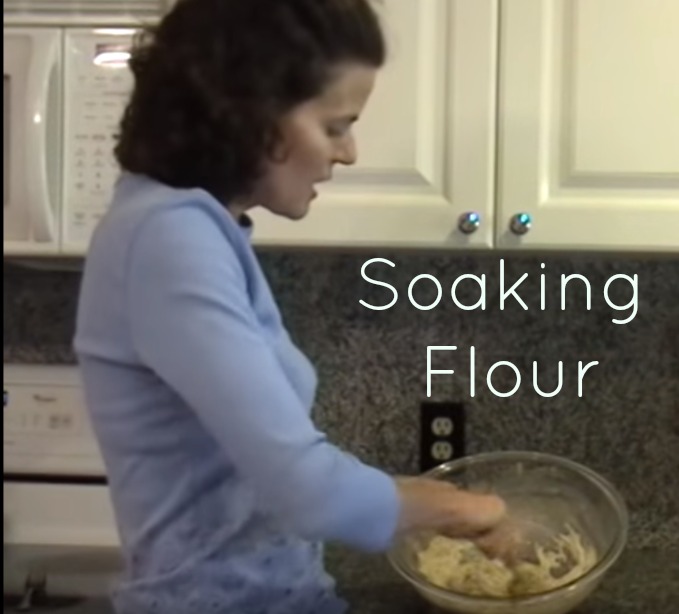Table of Contents[Hide][Show]
Soaking flour for maximum digestibility is one of the three traditional methods of grain preparation for healthy, nutritious bread as practiced by Ancestral cultures.
One of the most important baking techniques to learn when implementing a traditional diet is soaked flour. This ancestral method of grain preparation enhances digestibility and improves the metabolism of nutrients.
This technique also reduces anti-nutrients such as phytic acid in the grain flour. These substances block mineral absorption and can aggravate inflammation of the intestinal tract. Gluten-free grains also contain these anti-nutrients.
Other methods for reducing anti-nutrients in grains and improving metabolism include sour leavening (sourdough) and sprouting.
How to Soak Flour
Soaking flour is simple. Simply mix grain flour with yogurt, kefir, or clabbered milk, cover with a dishtowel, and let sit on the counter overnight. Freshly ground flour produces the best results. After the allotted soaking time, blend in the remaining ingredients and bake or cook as usual.
Non-grain based flours such as cassava and coconut flour do not need soaking. Others such as almond flour and chickpea flour are best soaked before grinding rather than after.
Dairy-Free
For those with milk allergies, substitute 1 cup of filtered water per cup of flour plus 2 TBL of lemon juice or apple cider vinegar and soak as usual for at least 8 hours or overnight.
For those with more extreme wheat sensitivities, the soaking time can be increased up to 24 hours to further breakdown gluten and other anti-nutrients.
Soaking any longer than 24 hours risks the development of mold.
Soaking Flour Technique Applies to All Grains
The principle of soaking can be applied to whole grains as well, such as your morning oatmeal. It was common to soak oats overnight before cooking back before WWII. This step was apparently even suggested on the Quaker oatmeal box!
It seems with the modern preference for speed in food preparation, this essential step has been lost. Hardly anyone under the age of 80 even remembers it anymore.
Try soaking your oatmeal the night before and see how much more filling it is after you cook and eat it the next morning.
Instead of being hungry again at 10 am, you will likely be full right through until lunch! To soak oatmeal, use 1 cup of warm filtered water per cup of oats plus 2 TBL whey, yogurt, kefir, or buttermilk. Stir together in the pot you will cook them in, cover with the lid, and leave overnight.
Cook, as usual, the next morning.
Bread Recipes Using Soaked Flour
Try this soaked bread recipe with your soaked flour. You can also try making a soaked loaf in a bread machine.
The video in the recipe tutorial below demonstrates visually the simple process of soaking flour. Try it with your next flour-based recipe!

How to Soak Flour
How to soak flour of all kinds before making the batter to improve digestibility and nutritional benefits of bread and other baked goods.
Ingredients
- 2 cups flour preferably freshly ground and organic
- 2 cups whole milk yogurt
Instructions
-
Mix flour and yogurt in a large bowl.
-
Cover with a clean dishcloth and secure with a large rubber band.
-
Leave on the counter overnight or for 8 hours.
-
Uncover, mix in remaining ingredients for whatever recipe you wish to make and bake as usual.
Recipe Video
Recipe Notes
Clabbered milk or plain kefir may be substituted for yogurt.
If there is a dairy allergy, 2 cups of water plus 2 Tbl lemon juice may be substituted. This reduces the calories to 910 for one batch.








Can you soak freshly ground brown rice flour the same way?
How about procedures for soaking almond flour? Is coconut flour any different?
Yes these are different foods from grains. This article talks about soaking coconut flour: https://www.thehealthyhomeeconomist.com/should-coconut-flour-be-soaked/
This article on how to soak almonds before making almond flour: https://www.thehealthyhomeeconomist.com/video-raw-nuts-done-right/
How would you make bread out of this..
If it is soaked and you add more flour then that portion will be soaked.. confused here
Since you have already added liquid does that change the amount of liquid you need to add later? eg. if recipe calls for 1.5 cups of water do you use less?
You mention in the video, that nothing is lost by freezing the freshly ground fluor.
However, on other websites, I have seen it pointed out that the enzyme “phytase” (which helps breaking down the specific anti-nutrient “phytic acid”), might not survive freezing.
I would love to hear your opinion on that.
By the way, I think I am going to soak some flour overnight, with what I have at hand.
I only have some store-bought preground wheat flour (organic though), and I think I am going to add some Asorbic Acid powder to the water for the acidity.
I guess tomorrow I will find out if turns out catastrophic… or really great.
I haven’t seen any research on phytase not surviving the freezing process. Can you post a link?
Hi Sarah, how much whey would you recommend to drink on its own.
Tanks Marosh
Whey is to be used in the kitchen in very small amounts mixed with water for soaking flour, grains, and seeds etc, not as a beverage on its own.
So if you’re making a cake and want to soak the flour (I’m using raw slightly soured milk), do you soak with I cup liquid per cup flour, and then add the rest of the liquid when you finish making the batter? Would you combine wet and dry separately as usual and then add the remaining dry to the soaked flour before adding the wet ingredients or does it matter?
Sarah,
I am “late to the party” at age 57, but I have become increasingly aware that I want and need to take better care of my body. If I am starting with zero knowledge, where would I begin looking for information about what you teach? I live in central Florida near the west coast of the state, and sadly, I’m not even sure where to find some of the supplies you mention in your videos. I had a serious health issue in 2015, which only further fired my desire to be a better steward of my body. Thank you for any help you are willing to share.
Best to you,
Michele
If you can’t find what you need in local stores, I would suggest Amazon. You can ship in almost anything necessary for traditional cooking at home.
Good day
I have made some soaked pancake and they are sooo sour ! Almost not edible. I have follow the nourishing tradition recipe ! Do you know how to remove that strong sour taste
thank you so much for your response
I know this is an old question, but I follow the recipe in the NT kids cookbook and have never had sour trading pancakes. 1 cup kefir, whey, or buttermilk, 1-1/2 cups whole grain flour 1/2 tsp sea salt, 2 eggs, 1/2 tsp baking soda and I use lots of cultured butter on my cast iron griddle and then top with more butter as they come off. I make a huge batch every week and freeze leftovers with wax paper between layers and reheat in the oven as needed (I always have pancakes in my freezer)
Hi Sarah,
I am from India and the temperatures in the summer go as high as 48 deg cel. I wanted to know that when you are soaking the flour to make a tortilla dough or for any other purpose, doew the temperature of the room have an effect on it? and if yes what is the correct time and temperature?